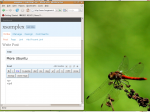- The installation of MonoDevelop was a no-brainer: I think the .Net runtimes are installed the moment you install Ubuntu. I may port one minor application to Mono, if I have time later this evening.
- At one time, I despised the multiple ‘desktop’ panels that are part of (most) Linux Windows managers. Nowadays, I’ve learnt to appreciate it: I gather that you should keep them limited to 2 or 4. I chose to keep the default set of panels (2 columns, 1 row)
- Generally, keyboards shortcuts follow Mac and Windows standards. You may want to see into this document explaining all (or most) known shortcut keys known for Gnome and KDE.
- I heart Audacity, which was one of the first apps I installed yesterday. Getting the application to both record and play was a bit of a nuisance: Make sure to go into the preferences (Edit | Preferences) and set both PlayBack and Recording sections to the proper sound card devices. I only got this going (both recording and playback) by plainly experimenting. The default Audacity settings definitely won’t work right out of the box.
- Talking about sound: I haven’t settled on which mediaplayer to use. For now I use Ubuntu’s default one, which is RythmBox.
- The specific graphical effects (I think these come from Compiz, which is installed by default too) work good on the built-in (and ‘low-end’) Mobile Intel 910 GMA card. So do the transparency effects, but, I have seen these in earlier Knoppix versions (which is KDE based, as you probably know) so these don’t really surprise me.
Without a doubt, you’ll run in a couple of hardware weirdness, all of them generally easy to solve: Ubuntu has started a LaptopTesting wiki where contributers test and write about their experiences installing Ubuntu on older laptops. An excellent resource, particularly for the laptop (an HP NC6120) I used. In my case, the Wifi-LED didn’t reveal if it was active or not while Ubuntu had already correctly made a WIFI connection to my network. This was easily fixed and it actually changed the behaviour of the WIFI-LED: currently the LED is blinking while it tries to make a connection (or whenever it finds wireless networks). That’s even better, not?
Update 1: For more recent versions of software, you should check out GetDeb, from which you can get the latest version of UFRaw (which I mentioned earlier).

